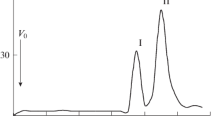Abstract
Lipopolysaccharide (LPS) preparations of 34 Pseudomonas syringae strains of 19 pathovars were prepared by saline extraction from wet cells and purified by repeated ultracentrifugation. The preparations reacted with homologous O-antisera, obtained by rabbit immunization with heat-killed bacterial cells. Through inhibition of homologous reactions between LPS preparations of heterologous strains (enzyme immunoassay, EIA), it was established for the first time that high serological affinity between strains is observed only if their LPS contains O-specific polysacc haride chains (OPS) comprised of completely identical rather than partially similar units. The central linear part of the OPS was found to be serologically inert when shielded with side groups. Data on immunochemical characteristics of the LPS and OPS structure are analyzed in relation to the design of P. syringae classification scheme.
Similar content being viewed by others
References
Young, J.M., Saddler, G.S., Takikawa, Y., DeBoer, S.H., Vauterin, L., Gardan, L., Gvozdyak, R.I., and Stead, D.E., Names of Plant Pathogenic Bacteria 1864-1995. ISPP Subcommittee on Taxonomy of Plant Pathogenic Bacteria, Rev. Plant Phathol, 1996, vol. 75, pp. 721–763.
Gardan, L., Shafik, H., Belouin, S., Broch, R, Gri-mont, F., and Grimont, P.A.D., DNA Relatedness among the Pathovars of Pseudomonas syringae and Description of Pseudomonas tremae sp. nov.’Pseudomonas connabina sp. nov. (ex Sutic Dowson 1959), Int. J. Syst. Bacteriol., 1999, vol. 49, pp. 469–478.
Pastushenko, L.T. and Simonovich, I.D., Serological Groups of the Phytopathogenic Bacteria of the Genus Pseudomonas, Mikrobiol. Zh., 1979, vol. 41, pp. 330–338.
Saunier, M., Malandrin, L., and Samson, R., Distribution of P. syringae Pathovars into 23 O Serogroups, Appl. Environ. Microbiol., 1996, vol. 61, pp. 2360–2374.
Ovod, V.V., Zdorovenko, E.L., Shashkov, A.S., Kocharova, N.A, and Knire P, Yu. A, Structural Diversity of O-Polysaccharides and Serological Classification of Pseudomonas syringae pv. garcae and Other Strains of Genomospecies 4, Mikrobiologiya, 2004, vol. 73, no. 6, pp. 777–789 [Microbiology (Engl. Transl.), vol. 73, no. 6, pp. 666-677].
Zdorovenko, G.M., Varbanets, L.D., Zdorovenko, E.L., and Pozur, V.K., Lipopolysaccharides: Macromolecu-lar Organization, Composition, Structure, and Functional Biological Activity, in Struktura i biologicheskaya aktivnost’ bacterial’nykh biopolimerov (Structure and Biological Activity of Bacterial Biopolymers), Pozur, V.K., Ed., Kiev: Kiev Univ., 2003, pp. 83–156.
Zdorovenko, E.L., Zatonsky, G.V., Kocharova, N.A., Shashkov, A.S., Knirel, Y.A., and Ovod, V., Structure of the O-Polysaccharides and Serological Classifification of P. syringae pv. porri from Genomospecies 4, Eur. J. Biochem., 2003, vol. 270, pp. 20–27.
Spitali, M. and Smith, A.R.W., Structure of Lipopolysaccharide Side-Chain of Pseudomonas syringae pv. tabaci Strain NCPPB 79 (=CFBP 1615), in Relation to O-Serogroup, J. Phytopathol., 2007, vol. 155, no. 1, pp. 1–7.
Varbanets, L.D., Zdorovenko, G.M., and Knirel’, Yu.A., Metody issledovaniya endotoksinov (Methods of Endotoxin Investigation), Kiev: Nauk. Dumka, 2006.
Ovod, V., Ashorn, P., Yakovleva, L., and Krohn, K., Classification of Pseudomonas syringae with Monoclonal Antibodies against the Core and O-Side Chains of the Lipopolysaccharide, Phytopathology, 1995, vol. 85, no. 2, pp. 226–232.
Zdorovenko, E.L., Zatonsky, G.V., Zdorovenko, G.M., Pasichnik, L.A., Shashkov, A.S., and Knirel, Y.A., Structural Heterogeneity in the Lipopolysaccharides of Pseudomonas syringae with O-Polysaccharide Chains Having Different Repeating Units, Carbohydr. Res., 2001, vol. 336, pp. 329–336.
Zdorovenko, E.L., Lipopolysaccharide Structure as a Basis for Classification of the Phytopathogenic Bacteria Pseudomonas syringae, Cand. Sci. (Chem.) Dissertation, 2002.
Ovod, V., Zdorovenko, E.L., Shashkov, A.S., Kocharova, N.A., and Knirel, Y.A., Structure of the O-Polysaccharide and Serological Classification of Pseudomonas syringae pv. ribicola NCPPB 1010, Eur. J. Biochem., 2000, vol. 267, no. 8, pp. 2372–2379.
Ovod, V., Rudolph, K., Knirel, Yu., and Krohn, K., Immunochemical Characterization of O Polysaccha-rides Composing the a-D-Rhamnose Backbone of Lipopolysaccharide of Pseudomonas syringae and Classification of Bacteria Into Serogroups O1 and O2 with Monoclonal Antibodies, J. Bacteriol., 1996, vol. 178, no. 22, pp. 6459–6465.
Knirel’, Yu.A. and Kochetkov, N.K., Lipopolysaccharide Structure in Gram-Negative Bacteria. III. O-Antigen Structure, Biokhimiya, 1994, vol. 59, pp. 1784–1851.
Author information
Authors and Affiliations
Corresponding author
Additional information
Original Russian Text © G.M. Zdorovenko, E.L. Zdorovenko, 2010, published in Mikrobiologiya, 2010, Vol. 79, No. 1, pp. 52–62.
Rights and permissions
About this article
Cite this article
Zdorovenko, G.M., Zdorovenko, E.L. Pseudomonas syringae lipopolysaccharides: Immunochemical characteristics and structure as a basis for strain classification. Microbiology 79, 47–57 (2010). https://doi.org/10.1134/S0026261710010078
Received:
Published:
Issue Date:
DOI: https://doi.org/10.1134/S0026261710010078



